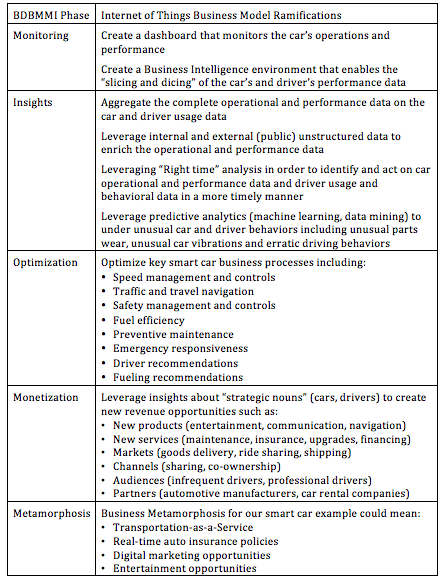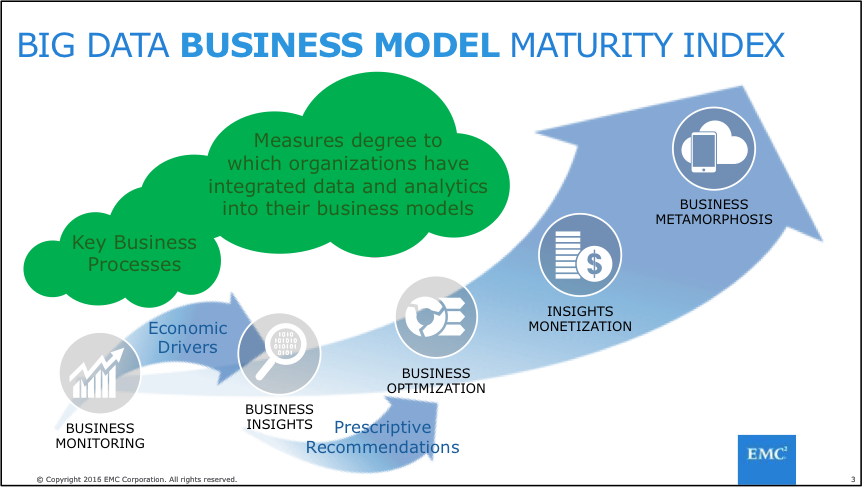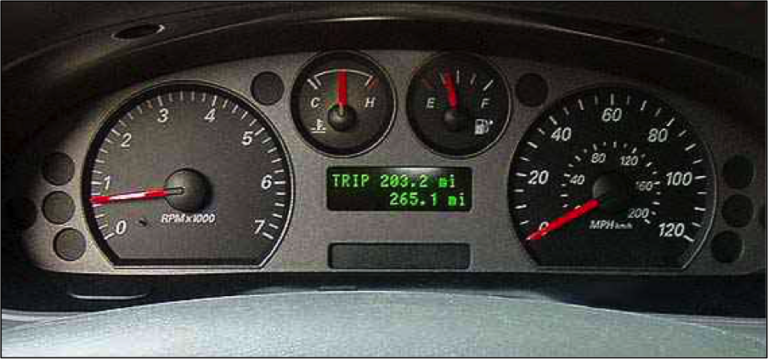Big Data Business Model Maturity Index and the Internet of Things (IoT)
This post explores how organizations could use the Big Data Business Model Maturity Index (BDBMMI) to exploit the Internet of Things (IoT).
Antonio Figueiredo (@afigueiredo) recently challenged me on Twitter with an interesting question: How would the Big Data Business Model Maturity Index (BDBMMI) change to support the Internet of Things (IoT)? My hope is that the BDBMMI would not need to change to support IoT. It is my hope that the BDBMMI could be used to guide any industry that is going through a data and analytics-driven transformation, such as what is happening to many industries due to IoT.
Let’s see how one could use the BDBMMI to help organizations to exploit the IoT. But before we start that exercise, let’s start with some key definitions:
- The Big Data Business Model Maturity Index (BDBMMI) is a framework to measure how effective an organization is at leveraging data and analytics to power the business (see Figure 1). We have successfully used the BDBMMI to help organizations not only identify where and how to start their big data journeys, but have used the BDBMMI framework to help guide organizations through the Insights, Optimization and Monetization phases.
- The Internet of Things (IoT) is the network of physical objects—devices, vehicles, buildings and other items—embedded with electronics, software, sensors, and network connectivity that enables these objects to collect and exchange data.[1] As discussed in a previous blog (Internet of Things: “Connected” Does Not Equal “Smart”), one of the ultimate goals of IoT is to create “smart” environments or devices – environments or devices that self-monitor, self-diagnose and eventually self-direct. In that article, I provided an example of what would be required to leverage IoT to create a “smart” city.
For this exercise, let’s build upon that article to see how we could use the BDBMMI with IoT to create a “smart” car (and I’d expect that this same process will work for creating other “smart” entities such as jet engines, turbines, lawnmower, cities, airports, schools, hospitals, etc.).
Applying the Big Data Business Model Maturity Index to IoT
Phase 1: Business Monitoring
The first phase of the BDBMMI is the Business Monitoring phase:
The Business Monitoring phase leverages data and analytics to monitor, or report on, the current state of the business.
The Monitoring stage leverages traditional Business Intelligence and Data Warehousing to provide retrospective, or descriptive, reports on “What has happened?”
While the Business Monitoring phase of the smart car transformation does not have the traditional Business Intelligence and data warehousing to support operational reporting needs, the smart car analogy does have one important item to monitor the operations and performance of our smart car…a dashboard (see Figure 2)!
If we wanted to drill further on the car monitoring needs, we might want to create a Business Intelligence and data warehouse environment to gather, report and trend additional information about the car’s performance and operations such as:
- Locations driven
- Travel routes
- Average speed (by driver)
- Times and locations driven over the speed limit
- Miles since last servicing
- Average fuel efficiency (MPG)
- Parts that are slowing wear
- Components that are not performing up to specs
- Driving violations (again, by driver)
- Etc.
As in the Big Data world, the Business Monitoring phase is necessary as it provides the detailed history of transactional and operational data that forms the basis for the next steps in the BDBMMI process.
Phase 2: Business Insights
The second phase of the BDBMMI is the Business Insights Phase:
The Business Insights phase applies the 4 Big Data economic value drives (detailed historical data, internal and external unstructured data, right-time analysis, predictive analytics) to uncover potential operational and behavioral insights buried in the data.
These four Big Data value drivers from the Business Insights phase can be applied directly to the smart car to uncover potential car operational and performance as well as driver behavioral insights by:
- Providing access the complete history of the car’s transactional and operational data at the individual sensor or node level, as well as the driver’s usage and driving behavioral data.
- Providing access to semi-structured (sensor logs, error codes, warning messages, vibration readings) and unstructured (customer feedback, mechanic notes, product specs, operating manual) data, as well as access to public data such as weather, traffic, accident reports, road conditions, road maintenance schedules, product defect notifications, consumer report ratings, National Highway Traffic Safety Administration (NHTSA) alerts, etc. There is also the opportunity to integrate additional data about the driver including age, years of driving experience, previous driving record, GPA, years of education, years driving this car, etc.
- Leveraging “Right time” analysis in order to identify and act on car operational and performance data (e.g., unusual wear in a car part, unusual car vibrations) and driver usage and behavioral data (e.g., erratic driving patterns) in a more timely manner (act within the time window to make a difference)
- Applying predictive analytics (e.g., data mining, machine learning) to uncover car performance and driver behavioral variations and deviations that might provide car performance and operational opportunities as well driver behavioral opportunities.
Phase 3: Business Optimization
The third phase of the BDBMMI is the Business Optimization phase:
The Business Optimization phase applies prescriptive analytics to optimize key business processes thru recommendations delivered to customers (drivers), front line employees (mechanics, engineers), and partners.
Our “smart” car would need a robust and detailed set of structured and unstructured data against which advance analytics (prescriptive analytics) to deliver operational and driver recommendations with the goal of optimizing key car and driver use cases including:
- Speed management and controls
- Traffic and travel navigation
- Safety management and controls
- Fuel efficiency
- Preventive maintenance
- Emergency responsiveness
- Driver behavioral (rest, eating) recommendations
- Fueling recommendations
- Etc.
Each of these use cases is comprised of numerous decisions that are being made by the car and the driver around which we would want to build prescriptive analytics (“Tell me what I should do?”) to help optimize that particular smart car use case. These prescriptive analytics would need to deliver recommendations to our key stakeholders (drivers, mechanics, police, emergency medical technicians, traffic control, etc.) in order to guide the stakeholders in the process of making better or optimal decisions.
Phase 4: Insights Monetization
The fourth phase of the BDBMMI is the Insights Monetization phase:
The Insights Monetization phase leverages insights on car’s optimized operations and performance to create new Big Data Business Model Maturity Index opportunities.
For our smart car example, we could leverage insights about the car’s operations and performance, and driver’s usage behaviors to create new revenue opportunities such as:
- New products (entertainment, communication, navigation, etc.)
- New services (maintenance, insurance, upgrades, financing, leasing, etc.)
- Markets (goods delivery, ride sharing, shipping, etc.)
- Channels (sharing, co-ownership, etc.)
- Audiences (infrequent drivers, professional drivers, etc.)
- Partners (automotive manufacturers, car rental companies, insurance companies, service garages, auto sales, etc.)
Phase 5: Metamorphosis Phase
The fifth phase of the BDBMMI is the Business Metamorphosis phase:The Business Metamorphosis phase enables analytics-enlightened consumption models that embedded the organization’s business models into the business models of their key customers, partners and channels.
For our smart car example, this could mean the following:
- Transportation-as-a-Service business model where drivers request and reserve cars for specific usage models (e.g., one-time usage, one-way usage, weekly usage).
- Real-time auto insurance policies that quote you a price for a fixed period of time but only if the customer drives the specified (more safe) route and speeds
- Digital marketing opportunities inside of the automobile (oh boy, more ads…)
- Entertainment opportunities inside of the automobile (just no Raffi and the “Banana Phone” please)
- And many, many more!
BDBMMI to IoT Transformation Summary
To summarize using the BDBMMI to guide an organization’s IoT transformation:

I hope that this exercise has demonstrated how the Big Data Business Model Maturity Index can guide any organization that seeks to leverage new sources of data and analytics can transform their business models. The Internet of Things (IoT) is just one example, and I’d expect that the BDBMMI could be applied as new sources of data are uncovered across a wide range of industries.
While the “smart” car market may seem to be the most obvious of plays, any industry that is trying to create “smart” products and capabilities can leverage the BDBMMI to guide their transformation.
If your organization isn’t taking the lead on these data and analytics-driven market and business opportunities, I’m sure that someone else it. You know what they say about the view of the second pack dog...
[1] Wikipedia; https://en.wikipedia.org/wiki/Internet_of_Things
Original. Reposted with permission.
Related:



